UK Employer Skills Survey 2022 – Scotland Report
Publication of Scotland results from the UK Employer Skills Survey 2022.
Skill-shortage vacancies
This chapter explores the proportion of employers with vacancies at the time of the survey, and if they experienced difficulties filling these vacancies. It looks at instances where these difficulties were caused by a lack of skilled applicants, and the impact that this had on employers.
Vacancies
Overall, a quarter of employers in Scotland (25%) had a vacancy at the time of the survey.
This was an increase from 2020, where one in ten (11%) reported a vacancy (i.e., vacancy incidence). The 2020 survey was undertaken during the COVID-19 pandemic at a time when employers were subjected to varying restrictions on their operations which is likely reflected in the 2020 figures. However, the proportion with a vacancy in 2022 (25%) was also a statistically significant increase from 2017, when the figure was 20%.
The largest increase in vacancy incidence (in percentage-point terms) was found among establishments with 50 to 99 employees, from 39% in 2020 to 68% in 2022. In contrast, among the smallest establishments with 2 to 4 staff, incidence of vacancies increased from 4% in 2020 to 12% in 2022.
The highest vacancy incidence by sector was in Health and Social Work and Public Administration (44% for each), followed by Education (38%), compared to 12% in the Primary Sector and Utilities. By ROA region, the highest vacancy incidence was in Edinburgh and Lothians (32%) while the lowest was in Dumfries and Galloway (17%).
“Vacancy Density” refers to the number of vacancies as a percentage of total employment. This figure was 4.8% in 2022, meaning that for every 100 people employed in Scotland there were approximately 5 vacancies. This was an increase on the equivalent 1.9% figure in 2020, and the 3.1% figure in 2017.
While medium-to-large employers reported higher incidence of vacancies, smaller establishments had a higher vacancy density. The density for establishments with 2 to 4 staff was 7.1%, compared to 3.9% for those with 100 or more staff. This was a change from 2020, where the density was consistent across establishment size.
By sector, employers with the highest vacancy density were in the Hotels and Restaurants (7.7%), Financial Services (7.3%) and Primary Sector and Utilities (7.3%) sectors. Conversely, those in Information and Communications (2.2%) and Education (2.6%) had the lowest vacancy densities.
Further data on the incidence and density of vacancies, as well as corresponding 2020 results, can be found in Tables 3 to 8 of the Background Tables.
Skill-shortage vacancies
Skill-shortage vacancies (SSVs) refer to vacancies which are hard to fill because of difficulties finding applicants with the required skills, knowledge and/or experience. Looking at the level of SSVs in the market is a good indicator of skill supply issues in an area.
Over four in ten (41%) of establishments with vacancies reported at least one vacancy that was hard to fill due to a skill-shortage issue. This equates to 10% of all establishments in Scotland, and a total of 36,800 SSVs. The proportion of all vacancies that are considered skill-shortage vacancies (SSV density) was 31%.
Compared to 2020, the proportion of all establishments with any SSVs increased from 3% to 10% in 2022 as shown in Figure 4. SSV density (calculated as skill-shortage vacancies as a proportion of all vacancies) was 31%, an increase from the 21% figure in 2020 and from the 24% figure in 2017.
The incidence of skill-shortage vacancies was highest in the Edinburgh and Lothians ROA region, though density of skill-shortage vacancies was highest in the West Lothian and Borders ROA regions
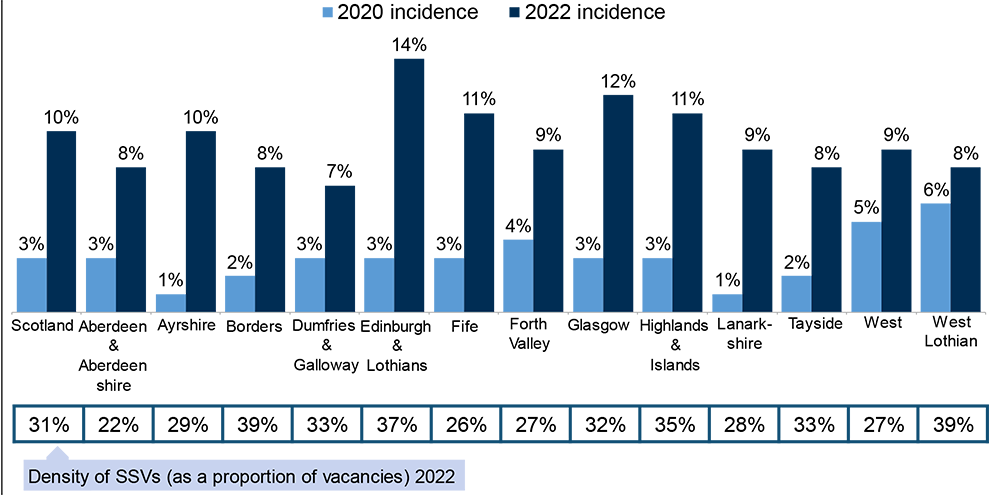
Base: All establishments in Scotland (2020: 3,497; ROA regional base sizes range from 87 in West Lothian Region to 500 in Highlands and Islands Region. 2022: 5,207; ROA regional base sizes range from 165 in Borders Region to 777 in Highlands and Islands Region). Base for density figures: Establishments with vacancies (2022: 1,790; base sizes by ROA region vary from 50 in Borders Region to 281 Edinburgh and Lothians Region). “Regions” refer to ROA regions – see “Definitions” section of this report for more detail.
Larger establishments were more likely to report having SSVs than smaller ones; just under a third (32%) of establishments with 100 or more staff had at least one SSV, compared to 5% of those with 2 to 4 staff.
By sector, establishments in Health and Social Work and Education were most likely to report having at least one SSV (16% and 15% respectively), aligning with their higher than average incidence of vacancies overall.
SSV density has previously been similar across size of establishment in Scotland, however in 2022 smaller establishments reported a higher SSV density than larger establishments (39% of those with 2 to 4 employees compared to 25% of those with 100 or more employees).
Further size and sector breakdowns, as well as corresponding 2020 results, can be found in Tables 9 to 14 of the Background Tables.
The highest SSV density by occupation was for Skilled Trades occupations (47%), followed by Associate Professionals (37%) as shown in Figure 5. The lowest SSV density was for Sales and Customer Services occupations (21%).
Compared to 2020, the largest increase in SSV density was in Administrative and Secretarial occupations, increasing from 8% in 2020 to 30% in 2022. A similar increase was seen for Elementary occupations, increasing from 8% in 2020 to 27% in 2022 as shown in Figure 5.
Density of skill-shortage vacancies was highest for Skilled Trades occupations, but the largest increase compared to 2020 was among Administrative occupations
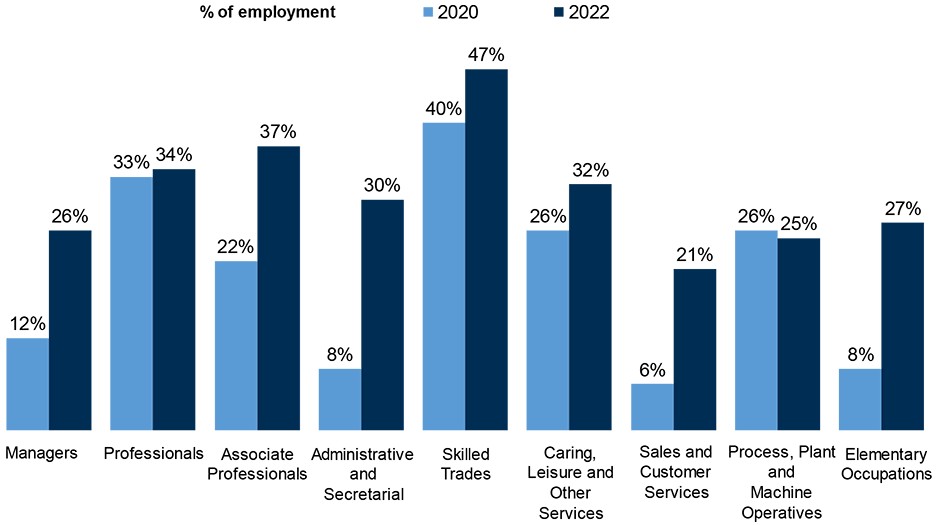
Base: All establishments with skill-shortage vacancies in Scotland (2020: 153; occupational base sizes range from 61 for Sales and Customer Services Staff Occupations to 144 for Caring, Leisure and Other Services Staff Occupations. 2022: 727; occupational base sizes range from 126 for Managers to 388 for Skilled Trades Occupations.)
Skills lacking in the available labour market
Employers were asked which skills they perceived to be lacking among applicants.
These were grouped into two broad categories:
- technical and practical skills, which are specific to the particular function of the job role, and
- people and personal skills, which are the “softer”, less tangible skills required to manage oneself and interact with other people in the workplace.
The most common technical skill identified by employers in Scotland to be lacking among applicants for vacancies was specialist skills or knowledge required for the role (57%), while the most common personal skill lacking was managing their own time and task prioritisation (48%).
When grouping specific technical and practical skills lacking (more information about how these grouped reasons have been defined can be found in the full UK report, which will be available on DfE’s website), just under half of all SSVs were caused, at least in part, by a lack of knowledge about the organisation (47%, similar to 46% in 2020), whether that was the products and services offered or how the organisation works.
Lacking complex analytical skills overall was a cause for SSVs for 46% of establishments (44% in 2020). Specifically, there was an increase in the proportion of SSVs caused, in part, by lack of skills related to solving complex problems (40% compared to 29% in 2020), though fewer SSVs were attributed to a lack of more complex numerical or statistical skills (24% compared to 31% in 2020).
Two-fifths (40%) of SSVs were due to a lack of basic IT or numerical skills (37% in 2020). While there was little change broadly in terms of basic skills, compared to 2020, there was a large increase in the proportion of SSVs caused, in part, by lack of basic numerical skills (30% compared to 13% in 2020), though SSVs caused by lack of basic IT skills had reduced (23% compared to 30% in 2020).
Figure 6 gives a full breakdown of the technical and practical skills lacking among applicants where employers reported having SSVs.
Lack of specialist skills or knowledge was the most common technical and practical skill lacking for skill-shortage vacancies
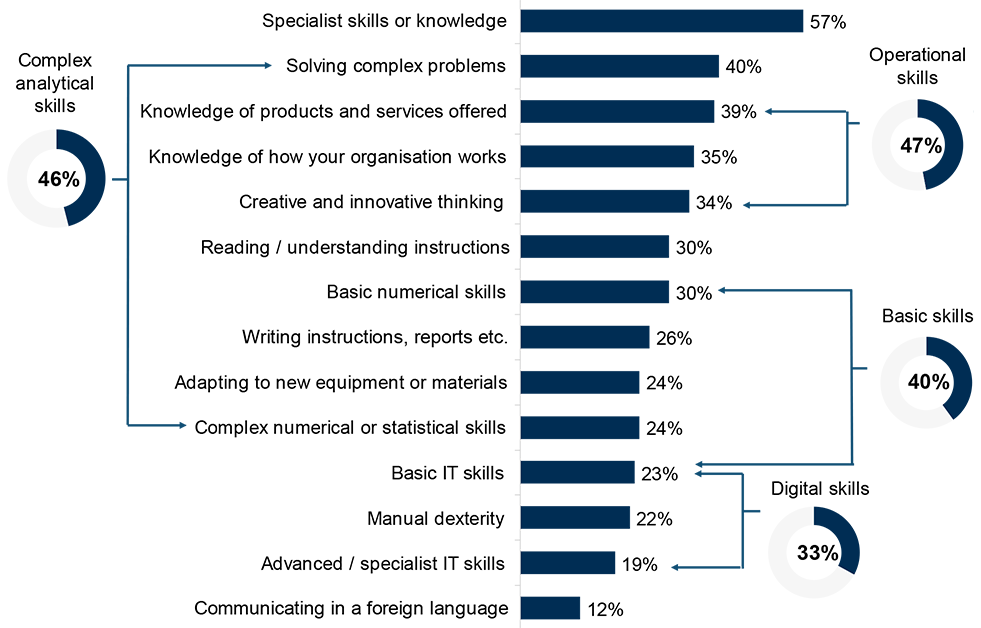
Base: All establishments with skill-shortage vacancies in Scotland (727)
Figures shown are based on SSVs for 2 occupations randomly selected for each establishment. For example, “specialist skills or knowledge” was lacking among applicants for 57% of SSVs followed up. Respondents were able to select multiple skills for these questions; as such grouped skills will not equal the total of the individual skills included in that grouping.
Focusing on specific digital skills lacking in applicants, a lack of basic digital skills were, in part, the cause of more than half (56%) of IT-related SSVs (digital SSVs), including foundation digital skills, such as turning on computers, changing passwords (35%), and Basic Microsoft Office application skills (31%). More than one in ten (11%) digital SSVs were due to a lack of basic internet skills, including not being able to communicate via email (8%). A small proportion of digital SSVs were due to a lack of graphic design / animation skills (6%).
Looking at people and personal skills (in Figure 7), the most common broad skill lacking among applicants was self-management, with 54% of SSVs caused at least in part by this. Around half (48%) attributed this partially to applicants not being able to manage their own time or prioritise tasks, while 37% felt it was linked to not being able to manage their own feelings or the feelings of others (an increase from 28% in 2020).
Around two-fifths (42%) of SSVs were caused due to a lack of management and leadership skills. The most common management or leadership skill to be lacking was managing or motivating staff, mentioned by 29% of establishments with SSVs. Sales and customer service skills were lacking for two-fifths (40%) of SSVs.
The most common people or personal skill lacking was applicants being able to manage their own time and task prioritisation
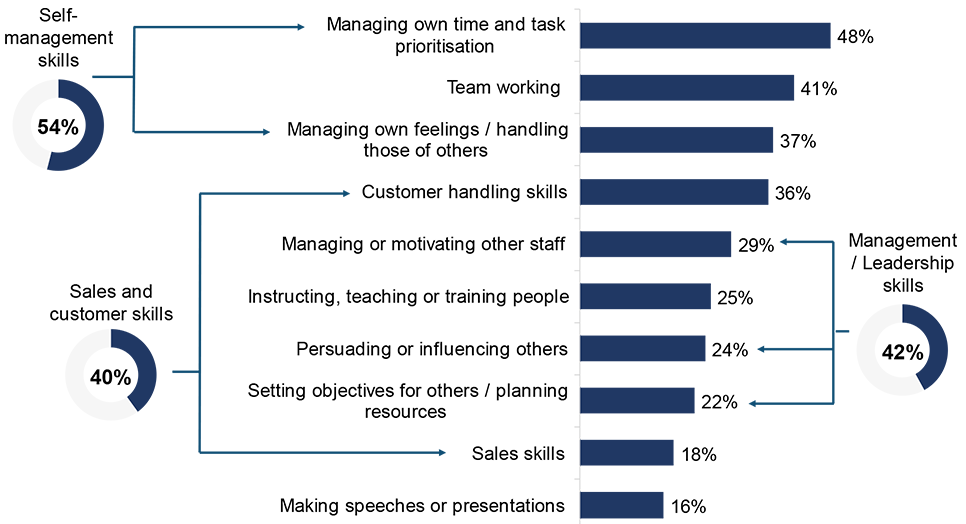
Base: All establishments with skill-shortage vacancies in Scotland (727)
Figures shown are based on SSVs for 2 occupations randomly selected for each establishment. For example, “managing own time and task prioritisation” was lacking among applicants for 48% of SSVs followed up.
Full comparisons to 2020 for skills lacking among applicants can be found in Tables 15 to 17 of the Background Tables.
Impact of skill-shortage vacancies on employers
Almost all (97%) employers that had experienced hard to fill vacancies that were all a result of skill shortages said these had an impact on their organisation. This was similar to the proportion reported in 2020 (95%).
The most common impact of SSVs was an increased workload for other staff, reported by 86% of establishments where all their hard-to-fill vacancies were caused at least in part by skill-shortages, an increase compared to 2020 (83%). For one in ten (10%) of these establishments, this was the only impact of SSVs on their organisation, similar to the 12% figure seen in 2020 for this measure. This was followed by having difficulties meeting customer service objectives (55%), experiencing increased operating costs (48%), and losing business or orders to competitors (44%) as shown in Figure 8.
In comparison to 2020, employers were more likely to report delays to developing new products or services as an impact of SSVs (43% compared to 31%) as well as having to withdraw from offering certain products or services altogether (33% compared to 21%). Other impacts which were also more pronounced compared to 2020 were having difficulties meeting quality standards (32% compared to 20%) and having to outsource work (35% compared to 24%).
A full comparison to 2020 on the impact of SSVs on employers can be seen in Table 18 of the Background Tables.
The most common impact of skill-shortage vacancies on establishments was an increased workload for existing staff
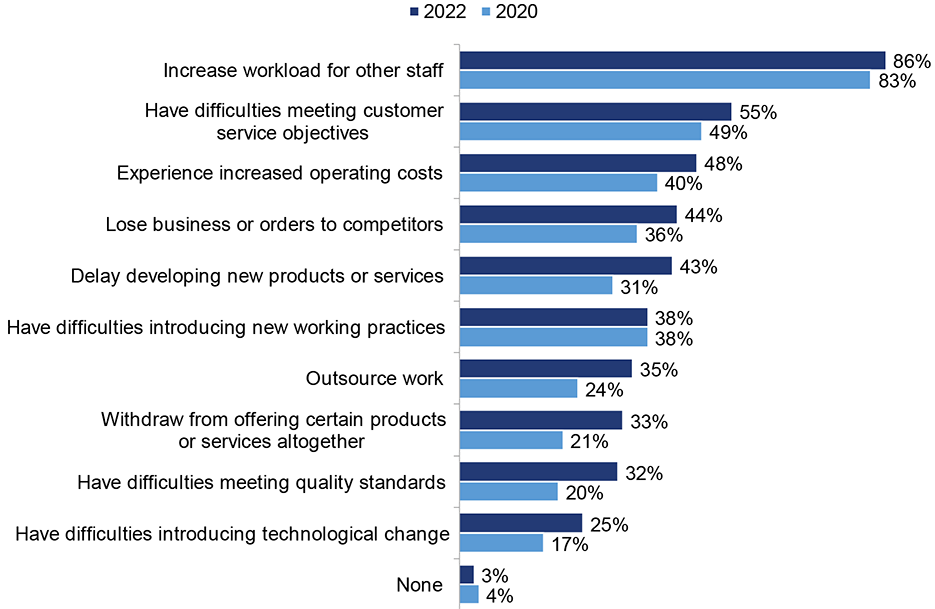
Base: All establishments in Scotland with hard-to-fill vacancies that are all as a result of skill shortages (2022: 602; 2020: 142).
Contact
Email: FHEstatistics@gov.scot
There is a problem
Thanks for your feedback